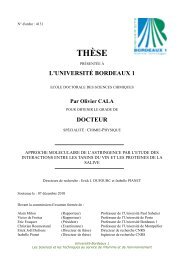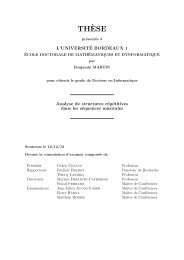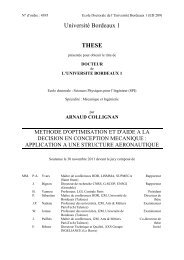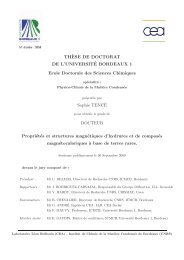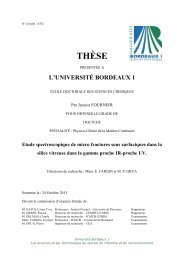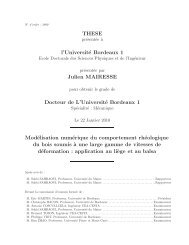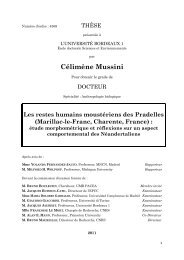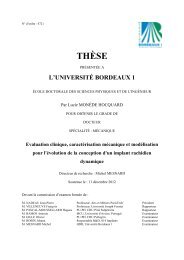de la structure à la croissance cellulaire - Université Bordeaux 1
de la structure à la croissance cellulaire - Université Bordeaux 1
de la structure à la croissance cellulaire - Université Bordeaux 1
Create successful ePaper yourself
Turn your PDF publications into a flip-book with our unique Google optimized e-Paper software.
116 M. Bourdon et al.<br />
4.2 Endoreduplication and Cell Differentiation<br />
In the mo<strong>de</strong>l p<strong>la</strong>nt Arabidopsis, the influence of endoreduplication in forming<br />
<strong>la</strong>rge specialized cells was best characterized in epi<strong>de</strong>rmal cells of mature leaves<br />
(Me<strong>la</strong>ragno et al. 1993), during hypocotyl <strong>de</strong>velopment in which the ploidy levels<br />
vary according to light conditions (Gendreau et al. 1997), and in leaf single-celled<br />
trichomes (Larkin et al. 2007). The growth of trichomes was shown to be <strong>de</strong>pen<strong>de</strong>nt<br />
on the succession of endocycles. The formation of a two-branched trichome cell<br />
requires three rounds of endocycle, leading to a 16C DNA ploidy level. A supplementary<br />
endocycle may eventually occur to give rise to the formation of a third<br />
branch and 32C DNA content. Moreover, cell growth and differentiation of trichomes<br />
is a genetically regu<strong>la</strong>ted process, since mutants affecting the nuclear<br />
ploidy level impacts positively or negatively on trichome cell size.<br />
As illustrated for trichomes, endoreduplication often occurs during the differentiation<br />
of cells that are highly specialized in their morphology or metabolism. This<br />
is the case for cells from tomato fruit pericarp and jelly-like locu<strong>la</strong>r tissues<br />
(Cheniclet et al. 2005; Lemaire-Chamley et al. 2005; Chevalier 2007) as <strong>de</strong>scribed<br />
above, for symbiotic host cells during the formation of nitrogen-fixing root nodules<br />
in legumes (Cebol<strong>la</strong> et al. 1999) and/or for the endosperm cells of maize kernels<br />
(Kowles and Phillips 1985; Kowles et al. 1990).<br />
4.3 Endoreduplication and Metabolism<br />
There are instances where endoreduplication is linked to endogenous metabolism.<br />
For example, nodule <strong>de</strong>velopment on legume roots is initiated in response to interaction<br />
with the symbiotic bacterium Sinorhizobium meliloti. During their differentiation<br />
process, symbiotic nodule cells, programmed to fix nitrogen, <strong>de</strong>velop into very <strong>la</strong>rge<br />
and highly endoreduplicated cells (Cebol<strong>la</strong> et al. 1999; Vinar<strong>de</strong>ll et al. 2003) and<br />
disp<strong>la</strong>y an important transcriptional activity that is remarkably specific to the nodule<br />
(Mergaert et al. 2003). Also, in Zea mays, endosperm cells accumu<strong>la</strong>te <strong>la</strong>rge amounts<br />
of starch and storage proteins, concomitantly with multiple and successive endocycles<br />
during seed <strong>de</strong>velopment (Lopes and Larkins 1993).<br />
Since a corre<strong>la</strong>tion exists between endoreduplication and cell differentiationspecific<br />
metabolism, it is tempting to specu<strong>la</strong>te that one role of endoreduplication<br />
would be to modu<strong>la</strong>te transcriptional activity by increasing the avai<strong>la</strong>bility of DNA<br />
temp<strong>la</strong>tes for gene expression as the gene copy number is obviously multiplied, and<br />
therefore, to modu<strong>la</strong>te subsequent trans<strong>la</strong>tional and metabolic activities. However,<br />
this hypothesis has neither been convincingly <strong>de</strong>monstrated nor negated in p<strong>la</strong>nt<br />
cells. For example, Leiva-Neto et al. (2004) showed that endoreduplication levels<br />
did not clearly impact on the expression level of some endosperm-specific genes,<br />
which led them to propose that endoreduplication in maize endosperm functions<br />
primarily to provi<strong>de</strong> a store of nitrogen and nucleoti<strong>de</strong>s during embryogenesis<br />
and/or germination.



